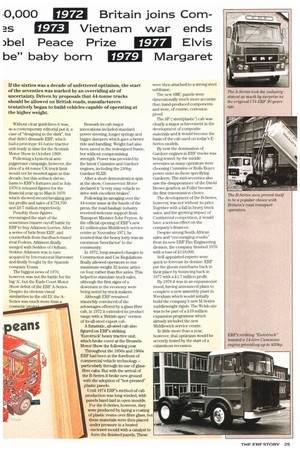lithe sixties was a decade of unfettered optimism, the start
Page 181

If you've noticed an error in this article please click here to report it so we can fix it.
of the seventies was marked by an overriding air of uncertainty. Driven by proposals that 44-tonne trucks should be allowed on British roads, manufacturers tentatively began to build vehicles capable of operating at the higher weight.
Without clear guidelines it was, as a contemporary editorial put it, a case of "designing in the dark", but that didn't dissuade ERF, which bad a prototype 44-tonne tractive unit ready in time for the Scottish Motor Show in October 1969.
Following a hysterical antijuggernaut campaign, however, the idea of a 44-tonne UR truck limit would not be mooted again in this decade, but this setback did no harm to ERFs fortunes and in July 1970 it released figures for the financial year up to March 1970 which showed record breaking pretax profits and sales of £734,700 and a9.7 million respectively.
Possibly those figures encouraged the start of the sometimes bizarre on/off battle by ERF to buy Atkinson Lorries. After a series of bids from ERF, and counterbids from Sandbach-based rival Fodens, Atkinson finally merged with Seddon of Oldham. Seddon Atkinson was in turn acquired by International Harvester and finally bought by the Spanish company Enasa
The biggest news of 1970, however, was not the battle for the big 'A', but the Earls Court Motor Show debut of the ERF A-Series. Despite its obvious visual similarities to the old DT, the ASeries was much more than a cosmetic irs'
Beneath its cab major innovations included standard power steering, longer springs and bigger dampers which gave a better ride and handling. Weight had also been saved in the redesigned frame, but without compromising strength. Power was provided by the latest Cummins and Gardner engines, including the 240hp Gardner 8LXB.
After a short demonstration spin at the show, COMMereilli Motor declared it "a very easy vehicle to drive with excellent brakes".
Following its savaging over the 44-tonne issue at the hands of the press, the road haulage industry received welcome support from Tkansport Minister .John Peyton. At the official opening of ERFs new al million-plus Middlewich service centre in November 1971, he insisted that the heavy lorry was an enormous 'benefactor' to the community.
In 1972, long-awaited changes in Construction and Use Regulations finally allowed operators to run maximum-weight 32-tonne artics on four, rather than five axles. This helped to stimulate truck sales, although the first signs of a downturn in the economy were being noted by truck makers.
Although ERF remained staunchly convinced of the advantages offered by a glass fibre cab, in 1972 it extended its product range with a 'British-spec' version of its all-steel export cab.
A futuristic, all-steel cab also figured on ERFs striking 'Eurotruck' heavy tractive unit, which broke cover at the Brussels Motor Show the following year.
Throughout the 1950s and 1960s ERF had been at the forefront of commercial vehicle technology particularly through its use of glassfibre cabs. But with the arrival of the B-Series it broke new ground with the adoption of 'hot-pressed" plastic panels.
Until 1974 ERF's method of cab production was long winded, with panels hand-laid in open moulds. For the B-Series, however, they were produced by laying a coating of plastic resins over fibre glass, but these materials were then placed under pressure in a heated enclosed mould with a catalyst to form the finished panels. These were then attached to a strong AM subframe.
The new SMC panels were dimensionally much more accurate than hand-produced components and were, of course, corrosion proof.
The SP ('steel/plastic') cab was clearly a major achievement in the development of composite materials and it would become the basis of the cab used on today's ESeries models.
By now the domination of Gardner engines in ERF trucks was being tested: by the middle seventies as many operators were choosing Cummins or Rolls Royce power units as those specifying Gardners. The mid-seventies also saw the disappearance of the David Brown gearbox as Fuller became the first transmission choice.
The development of the El-Series, however, was not witImut its price. Together with a fall in heavy truck sales, and the growing impact of Continental competition, it would have a serious effect on the company's finances.
Despite strong South African sales and "encouraging results" from its new ERF Fire Engineering division, the company finished 1976 With a loss (4E118,000.
Self-appointed experts were quick to forecast its demise. ERF put the gloom merchants back in their place by bouncing back in 1977 with a al.7 million profit.
By 1978 it was in an expansionist mood, having announced plans to complete a new assembly plant in Wrexham which would initially build the company's new M-Series middleweight rigids. The Welsh site was to be part of a SIO million expansion programme which already included the new Middlewich service centre.
In little more than a year, however, that optimism would be severely tested by the start of a calamitous recession.




































































































































































































